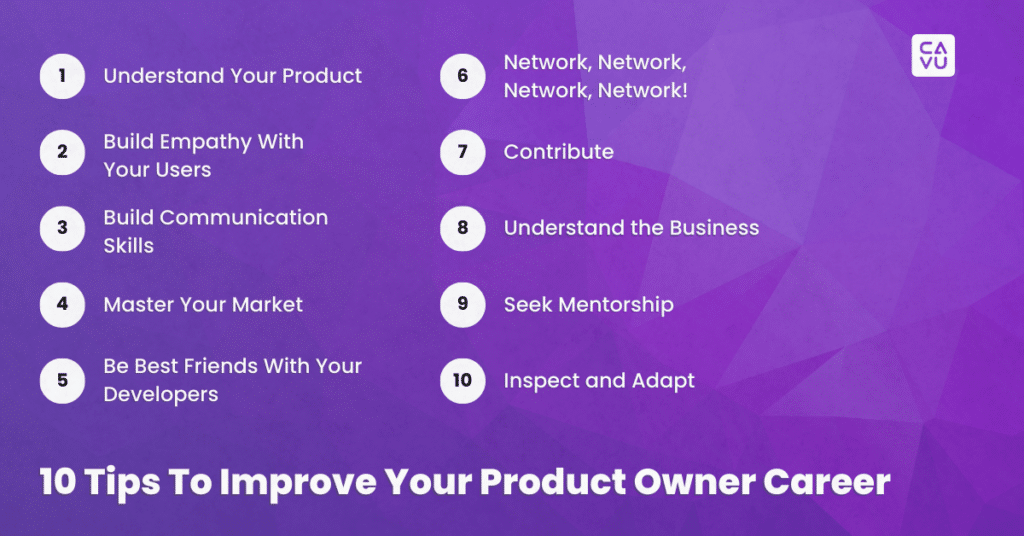As Agile continues to revolutionize software development and project management, the role of the Product Owner has emerged as a pivotal force driving successful product outcomes. Whether you’re an aspiring Product Owner just starting your Agile journey or a seasoned professional looking to sharpen your skills, navigating the path to success in this role requires a blend of industry knowledge, strategic thinking, and interpersonal skills. These tips to improve your Product Owner Career are here to help!
In this ever-evolving landscape, staying ahead means not only keeping pace with the latest Agile practices but also honing your ability to empathize with customers, collaborate effectively with teams, and steer the product vision with confidence. From building empathy with your customer to developing a strategic mindset, these insights are designed to propel your career forward and help you emerge as an influential Product Owner.
Let’s dive in and explore the key strategies and best practices that will sharpen your expertise, enhance your leadership abilities, and position you at the forefront of Product Ownership.

Tip #1: Understand Your Product
The journey to becoming an exceptional Product Owner begins with a deep, nuanced understanding of your product. But remember, as a Product Owner, you are never your user. This fundamental truth is often overlooked, yet it’s critical in shaping a product that truly resonates with its end-users.
To truly master your product, step into the shoes of those who use it daily. Consider working the help desk or spending time in the field alongside your customers. Experience the day-to-day challenges and delights they encounter with your product. This immersive approach allows you to witness firsthand the ‘good, bad, and ugly’ aspects of your product’s usage.
By becoming a user yourself, you gain invaluable insights that go beyond theoretical knowledge or second-hand feedback. This experience deepens your empathy, enabling you to understand the pain points, joys, and needs of your users on a much more profound level. It’s about seeing your product through their eyes, feeling their frustrations, and celebrating their moments of triumph.
Tip #2: Build Empathy With Your Users
Becoming a user will help you build empathy for your users. This is not just a skill – it’s an essential practice. Remember, your user base might span across continents, encompassing a wide array of cultural and regional nuances. It’s crucial not to fall into the trap of assuming that understanding local users equates to an understanding of all your users.
Traveling to meet your users where they are can be an eye-opening experience. Engaging with users from various regions or even the other side of the world can provide you with a broader perspective on how your product fits into different cultural contexts and everyday lives. These interactions offer invaluable insights that can’t be captured through reports or virtual meetings alone.

When you make the effort to step into the environments of your global users, you start to appreciate the unique ways in which they interact with your product. This understanding is key to developing a product that is truly inclusive and resonates with a global audience. It enables you to identify specific needs, preferences, and pain points that may vary significantly from one region to another.
Tip #3: Build Communication Skills
As a Product Owner, your ability to communicate effectively is not just an asset—it’s an absolute necessity. You’ll spend the majority of your time communicating with various stakeholders, teams, and users. To excel in this role, you must become an expert communicator, adept at both conveying your ideas and understanding others’.
One innovative way to enhance your communication skills is through organizations like Toastmasters. Toastmasters offers a structured environment where you can practice public speaking and leadership skills in a supportive setting. It’s an excellent platform for honing your ability to articulate ideas clearly and confidently, skills that are invaluable in stakeholder meetings, team discussions, and user interviews.
Additionally, consider enrolling in an acting class. Acting isn’t just about performing on stage; it’s about storytelling, expressing emotions, and connecting with an audience. As a Product Owner, these skills can help you narrate your product’s story compellingly, making a more profound connection with your audience, be it during a sprint review or a stakeholder presentation.
Effective storytelling is a powerful tool in the Product Owner’s arsenal. It enables you to craft narratives that resonate with your audience, whether you’re explaining the ‘why’ behind a product feature, advocating for user needs, or inspiring your team with the product vision.
Remember, as a Product Owner, you’re not just managing a product; you’re also leading people. Developing your communication skills helps build trust, foster collaboration, and ensure that your vision for the product is understood and shared by all stakeholders.
Tip #4: Master Your Market
As a Product Owner, you are the bridge between your product and the ever-evolving marketplace. To make informed decisions and prioritize your backlog effectively, you need to be an expert in your industry.
Firstly, ask yourself: How often do you attend product trade shows and industry conferences? These events are goldmines for gaining insights into current trends, networking with industry experts, and understanding emerging technologies. They provide a platform to see firsthand what competitors are doing and to spot emerging market opportunities.
Secondly, develop a thorough understanding of your competitors. Who are they? What differentiates their products from yours? An in-depth competitive analysis is crucial. This knowledge helps you identify your unique value proposition and influences your strategic decisions.
Moreover, keep an eye on new entrants in the market. Startups and new companies often bring innovative ideas and disruptive technologies that can change the market landscape. Understanding these new dynamics is key to ensuring your product stays relevant and competitive.
Staying updated on market trends is another critical aspect. Read industry reports, follow relevant blogs, and participate in online forums. This continuous learning helps you anticipate market shifts and align your product roadmap accordingly.
Remember, mastering your market isn’t just about understanding your current position; it’s about foreseeing where the market is heading and ensuring your product aligns with those future needs.
Tip #5: Be Best Friends With Your Developers
A successful Product Owner doesn’t just manage products; they cultivate strong, collaborative relationships with their teams. The synergy between you and your developers is a critical component of your role. Your job starts with identifying and understanding user problems and then effectively communicating and prioritizing these to your developers. From there, it’s up to the developers to transform these problems into viable solutions.
Think of your relationship with your developers as a partnership. The strength of this partnership directly influences the quality and efficiency of the solutions your team creates. A robust and open line of communication ensures that you are on the same page, leading to better understanding and execution of the product vision.
Here are a few strategies to strengthen your bond with your team:
- Regular and Open Communication: Engage in Daily Scrums, Retrospectives, and informal check-ins. Clear and consistent communication helps to build trust and ensures that everyone is aligned with the project goals.
- Show Empathy and Understanding: Take time to understand the challenges your developers face. Empathy goes a long way in building mutual respect and a supportive work environment.
- Foster a Culture of Collaboration: Encourage an environment where ideas and feedback are openly shared. Remember, the best solutions often come from collaborative efforts.
- Be Transparent: Share your thought process behind prioritizing certain features or tasks. Transparency in decision-making helps developers understand the ‘why’ behind their work, leading to greater buy-in and motivation.
- Empower Your Developers: Give your team the autonomy to make technical decisions and innovate. When developers feel empowered, they are more engaged and committed to delivering their best work.
- Celebrate Success Together: Acknowledge and celebrate the milestones achieved by your team. Recognition of effort and success fosters a positive team spirit.
By investing in a strong relationship with your developers, you’re not just improving communication and collaboration; you’re also building a foundation for creating the best possible solutions to your users’ problems.
Tip #6: Network, Network, Network, Network!

Networking is a universal key to career success, and this holds especially true for Product Owners. In the intricate web of product development, the strength and breadth of your professional network can significantly impact your effectiveness and growth in the role. Remember, your job’s effectiveness is often as robust as your network.
Cultivating relationships across your organization and within the broader Agile and product management communities is not just about expanding your list of contacts. It’s about building a support system, gaining diverse perspectives, and accessing a wealth of knowledge and opportunities. Here are some strategies to enhance your networking:
- Join Professional Groups: Become an active member of professional groups, both online and offline. Platforms like CAVU, LinkedIn groups, Agile Alliance, Agile forums, and local meet-up groups can be invaluable.
- Build Internal Networks: Within your organization, make an effort to connect with different departments. Understanding various internal functions enriches your perspective and helps in aligning product goals with broader company objectives.
- Be Genuine in Your Interactions: Authenticity is key in networking. Genuine connections are far more valuable and enduring than superficial contacts.
Your network is a dynamic resource that provides insights, advice, feedback, and support. It’s an essential tool in navigating the complexities of product ownership and can be instrumental in unlocking new opportunities and pathways in your career.
Tip #7: Contribute
Sharing your insights, experiences, and expertise not only solidifies your understanding but also establishes you as a thought leader in the space.
Getting published in industry blogs, newsletters, and journals is a great way to start. Whether it’s sharing a case study, offering solutions to common challenges, or presenting new ideas, your contributions can spark discussions and add value to the community. Here’s how you can make your mark:
- Write Articles and Blog Posts: Share your experiences and insights in written form. Platforms like Medium, LinkedIn, and industry-specific blogs are great places to publish your thoughts.
- Participate in Podcasts and Webinars: Offer to speak or participate in discussions on topics related to product management and Agile methodologies.
- Conduct Workshops or Speak at Conferences: Apply to be a speaker or workshop facilitator at industry events. This not only boosts your visibility but also enhances your credibility.
- Contribute to Online Forums: Engage in online communities and forums by answering questions, providing advice, or sharing resources.
- Collaborate on Research: Partner with academic or industry researchers to explore new trends or document case studies in product management.
Remember, each contribution enriches the global understanding of your domain and the role of Product Ownership. It’s a mutually beneficial process – as you contribute, you not only help others but also deepen your own understanding and expand your professional network. The more you contribute, the more you’ll find your network – and your influence within the industry – growing exponentially.
Tip #8: Understand the Business

A critical aspect of your job is to understand the financial and business implications of the decisions you make. This involves having a solid grasp of concepts like Return on Investment (ROI) and being able to analyze how each epic or feature impacts the business financially.
Here’s how you can deepen your business understanding:
- Learn to Calculate ROI: Develop the skill to calculate the Return on Investment for different features or epics. This involves understanding the cost of development versus the expected returns, which could be in terms of revenue, user growth, market penetration, or other business metrics.
- Understand Financial Metrics: Familiarize yourself with key financial concepts and metrics that are relevant to your product and company. This could include profit margins, cost-benefit analysis, lifetime customer value, and more.
- Align Product Decisions with Business Goals: Ensure that the decisions you make for the product align with the broader business goals and strategies. This alignment ensures that the product contributes positively to the company’s overall objectives.
- Collaborate with Business Stakeholders: Regularly interact with business stakeholders, including sales, marketing, finance, and customer support teams. This cross-functional collaboration will give you a holistic view of how your product fits into the larger business ecosystem.
- Stay Informed About Market Trends: Keep an eye on market trends and industry developments. This knowledge helps you anticipate changes and adapt your product strategy accordingly.
- Participate in Business Strategy Meetings: Whenever possible, get involved in business strategy discussions. This participation will give you a deeper insight into the company’s direction and how your product can contribute to its success.
Understanding the business implications of your decisions as a Product Owner is crucial. It not only helps in prioritizing the backlog with a business perspective but also ensures that your product consistently adds value to the company’s bottom line.
Tip #9: Seek Mentorship
Having a mentor who is experienced in Product Ownership can provide you with guidance, insight, and a deeper understanding of the role. This relationship is invaluable for navigating challenges, learning new strategies, and gaining perspectives from someone who has already walked the path you’re on.
Here’s how you can seek and benefit from mentorship:
- Leverage Your Network: Reflect on your professional network (referencing back to the importance of networking). Identify Product Owners whom you respect and look up to. Reach out to them and express your interest in learning from their experiences.
- Explore Professional Organizations: If you don’t have immediate contacts within your network, organizations like the Agile Alliance offer a community of professionals where you can seek mentorship. These organizations often have formal mentoring programs or can facilitate connections with experienced Product Owners.
- Be Proactive in Your Approach: When seeking a mentor, be clear about what you are looking for in the mentorship relationship. Whether it’s gaining insights into specific aspects of Product Ownership or seeking advice on career progression, having clear objectives helps both you and your mentor to get the most out of the relationship.
- Engage Regularly and Openly: Once you find a mentor, engage with them regularly. Be open about your challenges, successes, and aspirations. Honest communication is key to a fruitful mentorship.
- Implement Learnings: Act on the advice and insights provided by your mentor. The real value of mentorship lies in applying what you learn to your day-to-day role as a Product Owner.
- Give Back: As you grow in your role, consider mentoring others. Sharing your knowledge and experiences not only benefits others but also reinforces your own learning and understanding.
Mentorship is a powerful tool for personal and professional growth. It provides you with support, accelerates your learning curve, and helps you navigate the complexities of Product Ownership with more confidence and expertise.
Tip #10: Inspect and Adapt
In an Agile environment, continuous improvement isn’t just a goal; it’s a way of life. This principle dictates that you should consistently evaluate your methods, strategies, and outcomes, and be willing to make necessary changes.
Here’s how you can apply the ‘inspect and adapt’ approach:
- Regular Self-Reflection: Routinely take stock of your performance and approaches. Are the strategies you’re using effective in achieving your goals? Are there areas where you could improve?
- Embrace Feedback: Seek feedback from your team, stakeholders, and mentors. Constructive feedback is a goldmine for insights on areas where you can improve.
- Learn from Failures: Don’t shy away from failures. Instead, view them as opportunities for learning and growth. Analyze what didn’t work and why, and use these lessons to refine your approach.
- Stay Agile in Your Learning: The Agile mindset isn’t just for managing projects; apply it to your personal development as well. Be open to learning new skills, trying different techniques, and adjusting your path as needed.
- Set Improvement Goals: Based on your inspections and the feedback you receive, set specific, actionable goals for improvement. This could be anything from enhancing your communication skills to getting better at backlog prioritization.
- Track Your Progress: Keep a record of your growth and development. Regularly reviewing this can be a great motivator and can also help you identify patterns or areas that need more attention.
Remember, the journey of a Product Owner is one of constant evolution. By embracing the principle of ‘inspect and adapt’, you ensure that you are continuously growing and refining your skills. Be better today than you were yesterday and aim to be even better tomorrow.









